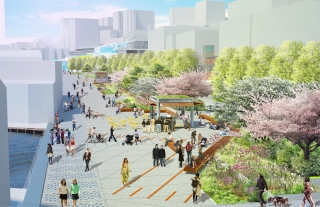|
Subscribe / Renew |
|
|
Contact Us |
|
| ► Subscribe to our Free Weekly Newsletter | |
| home | Welcome, sign in or click here to subscribe. | login |
Real Estate
| |
June 18, 2014
Panelists: Time for building owners to get ready for waterfront in 2016
Journal Staff Reporter
Big changes are coming to the Seattle waterfront, and a panel of developers and architects said Tuesday that it's time for some buildings in that area to start getting ready.
With a loud, hulking neighbor like the Alaskan Way Viaduct nearby, a number of buildings along the waterfront have been oriented toward the city and away from the water.
But once the viaduct comes down in 2016 or 2017, the owners will want to open up the waterfront side of their properties and make them more pedestrian friendly, the panelists said at an event put on by Bisnow. This will mean adding entrances and retail on the water side, and relocating back-of-the house functions.
“Every building has to have a backside for services and access to parking,” said Michael Lee of Callison. “When the viaduct comes down and all those sides of the building become exposed, how do you redevelop and repurpose them?”
Hudson Pacific Properties could have some renovation work to do on the waterfront portfolio it bought last year.
The Los Angeles-based company paid $367.5 million for four buildings that include 505 First Avenue/83 King Street. Then it paid $57.7 million for Merrill Place, a 179,000-square-foot office and retail building at 411 First Ave. S., and a separate 147-stall garage.
Several of Hudson Pacific's buildings are along First and Alaskan, and most of the entrances and retail spaces face onto First, away from the waterfront.
Drew Gordon of Hudson Pacific was on the panel. He compared the viaduct coming down to removal of the Embarcadero Freeway in San Francisco in the early 1990s. He said the city of Seattle is thinking ahead about rebuilding the waterfront, and property owners should also be planning.
“If you look you forward, two, three, four, five years that will be incredible space, and how existing properties have been historically oriented away from looking at the Sound will change dramatically,” Gordon said. “It's not just existing structures. Any new waterfront developments that are going to occur will be a complete game changer for the orientation of the waterfront.”
Several new public and private projects are being planned to take advantage of a redesigned waterfront.
Mack Urban said it plans to start construction this fall on a 16-story, 169-unit apartment project at 1301 Western Ave., which is now a parking lot next to a plant owned by Seattle Steam Co. Images show retail space and entrances facing Alaskan Way and the waterfront.
Goodman Real Estate is planning a 45-unit apartment building at 80 S. Main St. Construction could begin as early as this summer and take about 12 to 14 months.
The Miller Hull Partnership is designing a new building at Pike Place Market, and Seattle Aquarium is planning to add space as well.
Once the viaduct is removed, the city wants to create a waterfront promenade along the new Alaskan Way with better transit connections. The new waterfront is designed to connect to downtown and encourage pedestrians with wide sidewalks, trees and plantings, parks and public spaces, and maybe even a pool on a barge.
James Corner Field Operations of New York is leading the design team.
Seattle Planning Director Marshall Foster said the cost of the waterfront projects, the new seawall and rebuilding Alaskan Way is about $1.1 billion, and about 60 percent of that is funded. Early next year, the city will begin talking to the owners of property in downtown and along the waterfront about forming a local improvement district to raise between $200 million and $300 million. Property owners will be asked to pay based on how much they could benefit from the upgrades.
“We think long term about economic development in cities like Seattle where it is all about quality of place, it's all about the urban environment and having the amenities and stores and the urban experience that supports our downtown economy,” Foster said. “We feel like projects like the waterfront are really what we need to invest in for that next generation of economic development.”
The new waterfront will have a big impact on Pioneer Square. Greg Smith's firm Urban Visions is planning 200 Occidental, a 160,000-square-foot office project next to Occidental Park. Smith wants to start construction next March if that neighborhood's office market remains strong.
Urban Visions put together a chart that says zoning in Pioneer Square and the International District alone would allow for 10,000 new residential units, and 4 to 5 million square feet of office space.
“You're going to see what happens in south downtown is what happened south of Market in San Francisco,” he said. “It's just a giant canvas that's ready to rock and roll, and it is going to happen.”



